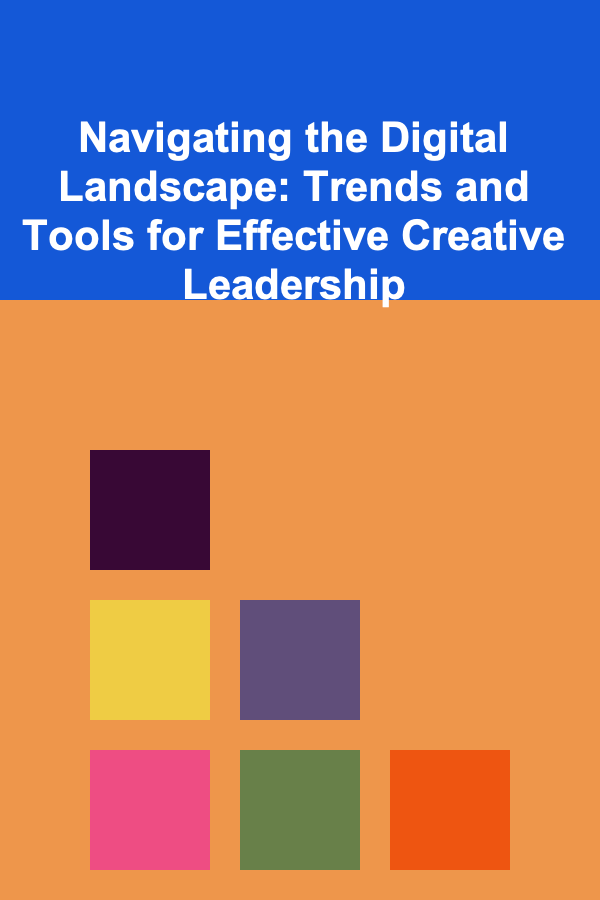
Navigating the Digital Landscape: Trends and Tools for Effective Creative Leadership
ebook include PDF & Audio bundle (Micro Guide)
$12.99$11.99
Limited Time Offer! Order within the next:

The digital landscape has transformed the way creative teams operate, pushing the boundaries of innovation, collaboration, and execution. As a creative leader, staying ahead of the curve means adapting to these shifts, utilizing new tools, and understanding emerging trends. The task is not just to keep up with the digital revolution but to harness its power effectively, leading your team with a vision that incorporates both creativity and technology. This article will explore the latest trends shaping the digital creative space and provide actionable insights on the tools that can help you lead your team to success.
Embracing the Remote and Hybrid Work Revolution
One of the most significant shifts in the digital landscape is the rise of remote and hybrid work. The COVID-19 pandemic accelerated the trend, and it's clear that these models are here to stay. For creative leaders, this shift presents both opportunities and challenges. Managing a remote or hybrid team requires a different set of skills, tools, and strategies to maintain productivity, collaboration, and morale.
Actionable Steps:
- Establish Clear Communication Channels: With remote teams, communication is more critical than ever. Invest in tools like Slack for real-time messaging and Zoom or Microsoft Teams for video conferencing. Make sure your team has clear guidelines on when and how to use each tool to avoid confusion.
- Foster a Strong Team Culture: Remote work can sometimes make it harder for team members to feel connected. Regular team check-ins, virtual happy hours, and creative brainstorming sessions can help build a sense of camaraderie. Use tools like Donut (a Slack integration) to encourage informal connections between team members.
- Leverage Cloud-Based Collaboration Tools: For creative projects, cloud-based tools like Google Drive, Figma, and Miro are indispensable. These platforms enable real-time collaboration and feedback, allowing your team to work seamlessly, no matter where they are located.
Prioritizing Data-Driven Decision Making
In the age of digital transformation, creative leaders can no longer rely solely on intuition or gut feelings. Data-driven decision-making is becoming increasingly important, and the availability of sophisticated analytics tools makes this more accessible than ever before. Understanding user behavior, campaign performance, and engagement metrics can provide valuable insights that inform creative direction and strategy.
Actionable Steps:
- Integrate Analytics into Creative Processes: Leverage tools like Google Analytics, Hotjar, or Crazy Egg to track user interactions on your websites and digital assets. This data can guide design decisions, helping you optimize user experiences and refine creative strategies.
- Use A/B Testing for Creative Decisions: A/B testing allows you to compare different versions of creative assets (such as email templates, landing pages, or ads) to determine which performs better. Tools like Optimizely and Unbounce provide easy-to-use platforms for running A/B tests, giving your team actionable insights.
- Collaborate with Data Scientists: If your organization has a data science or analytics team, collaborate with them to extract deeper insights from raw data. They can help you interpret trends and predict future behaviors, allowing you to make more informed decisions in your creative leadership.
Leveraging Artificial Intelligence (AI) and Automation
Artificial intelligence is no longer a futuristic concept---it's a present-day tool that can enhance creative processes. AI can automate mundane tasks, streamline workflows, and even assist in content creation. From design to copywriting, AI tools are becoming invaluable assets for creative leaders looking to increase efficiency and focus on strategic, high-value activities.
Actionable Steps:
- Automate Repetitive Tasks: Use AI-powered tools like Zapier or Integromat to automate repetitive tasks such as scheduling social media posts, tracking project progress, or managing file uploads. Automation frees up time for your team to focus on more creative aspects of their work.
- Explore AI for Creative Content Generation : Tools like GPT-4 (which powers ChatGPT), DALL·E, and Copy.ai can assist in generating creative content ideas, writing copy, and even designing visuals. While these tools shouldn't replace human creativity, they can provide inspiration and help speed up the ideation process.
- Utilize AI for Personalization: AI can help tailor content to individual users based on their preferences and behaviors. Tools like Adobe Sensei and Dynamic Yield use AI to personalize website experiences, ads, and email campaigns, ensuring that your creative output resonates with your audience.
Capitalizing on Social Media and User-Generated Content (UGC)
Social media has become a central platform for creative expression and brand engagement. The ability to reach large audiences and engage with them directly is a powerful tool for creative leaders. Additionally, user-generated content (UGC) is an increasingly important asset. It not only helps build trust but also provides a wealth of content that can be used to enhance brand visibility.
Actionable Steps:
- Build a Social Media Strategy: Develop a robust social media strategy that aligns with your brand's goals. Use platforms like Buffer, Hootsuite, or Sprout Social to schedule posts, track engagement, and analyze the performance of your content across various social channels.
- Encourage User-Generated Content: User-generated content (UGC) is a great way to build community and showcase your brand's impact. Encourage your audience to share photos, videos, and reviews that feature your products or services. Tools like Yotpo or TINT can help you collect and display UGC on your website and social channels.
- Utilize Influencer Partnerships: Influencers can amplify your brand's reach and drive engagement. Collaborate with influencers who align with your brand values and audience. Tools like Traackr and AspireIQ help manage influencer relationships and track campaign performance.
Staying Agile with Digital Project Management Tools
In a fast-paced digital world, agility is key. Creative projects are dynamic, and timelines often shift. Digital project management tools help creative leaders and teams stay organized, meet deadlines, and track progress, all while ensuring smooth collaboration.
Actionable Steps:
- Implement Agile Project Management : Agile methodologies, such as Scrum or Kanban, are highly effective for managing creative projects. Tools like Trello, Asana, and Monday.com allow you to break down complex projects into manageable tasks, assign responsibilities, and track progress in real-time.
- Encourage Iteration and Feedback: Agile is about flexibility and iteration. Foster a culture where feedback is encouraged at every stage of the project. Use tools like Figma or InVision to share prototypes and gather feedback from stakeholders, allowing for continuous improvement before final delivery.
- Set Clear Deadlines and Milestones: Even within an agile framework, it's essential to set clear deadlines and milestones. Use Gantt charts or Kanban boards to visualize timelines and ensure that everyone knows what's expected and by when.
Exploring the Metaverse and Immersive Technologies
The metaverse, virtual reality (VR), and augmented reality (AR) are emerging as powerful tools for creative leaders. These technologies allow for the creation of immersive experiences that can engage audiences in entirely new ways. While still in the early stages of mainstream adoption, the potential for VR and AR to revolutionize digital creativity is undeniable.
Actionable Steps:
- Experiment with Virtual and Augmented Reality: Platforms like Unity and Unreal Engine enable the creation of interactive 3D environments. If your brand is looking to provide immersive experiences, consider exploring VR and AR to create virtual product demonstrations, brand experiences, or even virtual stores.
- Explore Metaverse Platforms for Brand Activation: The metaverse offers new opportunities for brand activation. Platforms like Decentraland or Roblox are popular for virtual events, advertising, and creating branded virtual spaces. Experiment with hosting virtual events or creating branded assets within these platforms to engage your audience in new ways.
- Integrate AR into Marketing Campaigns: Augmented reality can be a game-changer in marketing. Use AR to create interactive print ads or virtual try-ons for products like clothing, eyewear, or cosmetics. Tools like Spark AR Studio from Facebook or ARKit from Apple can help you create engaging AR experiences.
Nurturing Digital Creativity and Innovation
Creativity and innovation are at the heart of every successful brand, and as a creative leader, it's your job to foster these elements within your team. The digital landscape offers a wealth of tools and resources to fuel creativity, but the most important ingredient is a culture of experimentation and continuous learning.
Actionable Steps:
- Promote Continuous Learning: Encourage your team to explore new tools, techniques, and trends. Invest in online courses, webinars, and conferences to ensure your team is always on the cutting edge. Platforms like MasterClass, Skillshare, and Coursera offer valuable educational resources.
- Foster a Culture of Experimentation: In the digital age, innovation is driven by experimentation. Encourage your team to try new things, whether that's testing out a new design tool or exploring a new social platform. Allow room for mistakes and learn from them.
- Celebrate Innovation and Risk-Taking: Reward creativity and innovation within your team. Recognize team members who take risks and think outside the box. This will inspire others to follow suit and contribute to a culture of creative experimentation.
Conclusion
Navigating the digital landscape as a creative leader requires more than just keeping up with trends and using the latest tools. It involves a strategic approach to leadership, empowering your team with the right resources, fostering a culture of collaboration and innovation, and continuously adapting to technological changes. By embracing the trends and tools outlined in this article, you can lead your creative team to success in an ever-evolving digital world, staying ahead of the competition and delivering exceptional, innovative outcomes.

How to Add Style to Your Home with Statement Lighting Fixtures
Read More
How to Choose Light Colors to Make Your Home Feel Bigger
Read More
How to Maintain a Dust-Free Home with Minimal Effort
Read More
How to Properly Clean and Maintain Your HVAC System
Read More
How to Start a Family Book Club with Engaging Reads
Read More
How to Use Drawer Organizers to Maximize Kitchen Space
Read MoreOther Products

How to Add Style to Your Home with Statement Lighting Fixtures
Read More
How to Choose Light Colors to Make Your Home Feel Bigger
Read More
How to Maintain a Dust-Free Home with Minimal Effort
Read More
How to Properly Clean and Maintain Your HVAC System
Read More
How to Start a Family Book Club with Engaging Reads
Read More